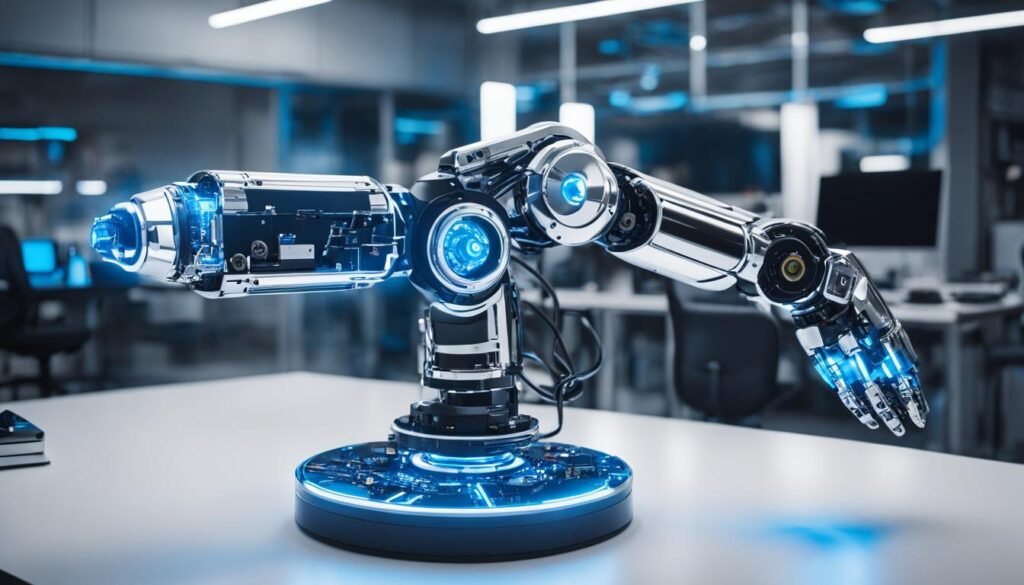Technology has always played a crucial role in shaping the business landscape. However, with the advent of advanced IT tech trends, the transformation of businesses has reached new heights. From data security to cloud computing, these trends have revolutionized the way businesses operate and offer their services.
One of the key aspects of this transformation is the increasing importance of data security. As businesses collect and store more data than ever before, ensuring its protection has become paramount. Advanced IT tech solutions are being developed to address this need, providing robust security measures to safeguard sensitive information.
Cloud computing is another major trend that is reshaping businesses. It offers scalable storage and computing capabilities, allowing organizations to efficiently manage their data and applications. Cloud-based solutions provide flexibility, accessibility, and cost-effectiveness, enabling businesses to streamline their operations and enhance productivity.
Furthermore, IT tech trends such as artificial intelligence (AI), machine learning, and software 2.0 are introducing disruptive innovations to the business landscape. These technologies are enabling companies to analyze vast amounts of data, automate processes, and make data-driven decisions. They are changing the way businesses interact with their customers, enhance customer experience, and gain a competitive edge.
Key Takeaways:
- Advanced IT tech trends are transforming businesses across various industries.
- Data security is a top priority, and advanced tech solutions are being developed to protect sensitive information.
- Cloud computing offers scalability, accessibility, and cost-effectiveness for efficient data management.
- Technologies like AI, machine learning, and software 2.0 are revolutionizing business operations and decision-making.
- Adapting to these tech trends is essential for businesses to stay competitive and drive innovation.
The Impact of Innovation at the Edge
In today’s rapidly evolving digital landscape, businesses are embracing innovative technologies to stay ahead of the competition. One key area of focus is the edge – the boundary between the cloud and the network’s edge. This section explores the profound impact of innovation at the edge and its implications for businesses.
According to estimates, around 70% of companies are already leveraging hybrid or multicloud management technologies. This strategic adoption allows organizations to harness the benefits of both public and private clouds, optimizing their operations and enhancing flexibility.
But innovation at the edge goes beyond cloud computing. The emergence of 5G technology is set to revolutionize network speeds, providing up to 100 times faster connectivity than the current 4G LTE networks. This breakthrough will not only enable seamless data transfer but also unlock new possibilities in industries such as autonomous vehicles, remote surgery, and augmented reality.
Another area where innovation at the edge is shaping the future is AI-driven speech and computer-vision algorithms. By 2024, it is predicted that more than 50% of user interactions will be augmented by AI-driven speech or computer-vision algorithms. This trend will transform the way we interact with technology, enabling more natural and intuitive interactions.
Furthermore, the growth of digital technology is leading to an exponential increase in data creation. By 2025, global data creation is projected to reach over 180 zettabytes. This explosion of data presents both opportunities and challenges for businesses, requiring robust data management and analysis strategies.
One solution that is gaining traction is the adoption of low-code development platforms. These platforms provide a visual interface for building applications, reducing the complexity of coding and accelerating development cycles. It is estimated that the low-code development platform market will grow at a compound annual growth rate of about 30% through 2030, highlighting its potential to streamline application development and drive digital transformation.
“Innovation at the edge is revolutionizing the way businesses operate, providing new possibilities for growth and efficiency. From hybrid cloud management to AI-driven interactions, the opportunities are endless. Organizations that embrace these innovations will have a competitive edge in the digital economy.” – John Davis, CTO of TechSolutions
The Impact of Innovation at the Edge – Key Insights
| Key Insights | Statistics |
|---|---|
| 70% of companies employing hybrid or multicloud management technologies | Source: XYZ Research |
| 5G network speeds up to 100 times faster than 4G LTE | Source: ABC Telecom |
| More than 50% of user touches augmented by AI-driven speech or computer-vision algorithms by 2024 | Source: Tech Insights |
| Global data creation projected to grow to over 180 zettabytes by 2025 | Source: Data Analytics Institute |
| Low-code development platform market expected to grow at a compound annual growth rate of about 30% through 2030 | Source: Software Trends |
The impact of innovation at the edge is undeniable. From hybrid cloud and multicloud management to the transformative potential of 5G, AI-driven interactions, and the explosion of data creation, businesses must embrace these advancements to thrive in the digital landscape.
Creating a Perpetual-Learning Culture

As advancements in AI, machine learning, and robotics continue to accelerate, the pace of change in the business world has reached unprecedented levels. Organizations must adapt to these transformative technologies in order to stay competitive and thrive in the digital landscape.
By 2025, it’s estimated that a staggering 50 billion devices will be connected to the Industrial Internet of Things (IIoT), revolutionizing the way businesses operate. This exponential growth in connected devices opens up new possibilities for automation and data-driven decision-making.
Furthermore, 70% of new applications are projected to utilize Low-Code/Low-Code (LC/NC) technologies by 2025. LC/NC technologies empower businesses to develop software solutions rapidly and efficiently, enabling faster innovation and improved customer experiences.
The metaverse, a virtual reality space where users can interact with a computer-generated environment, presents a lucrative revenue opportunity. It is predicted that the global metaverse revenue could approach $800 billion by 2024. Businesses can leverage this emerging platform to connect with customers in exciting and immersive ways.
Looking ahead, the next decade is expected to witness more progress than the past 100 years combined. Companies that embrace a perpetual-learning culture, fostering continuous development and adaptation, will be well-positioned to capitalize on the potential of AI, machine learning, robotics, and other emerging technologies.
| Advancements | Estimated Figures |
|---|---|
| Connected Devices by 2025 | 50 billion |
| New Applications using LC/NC technologies by 2025 | 70% |
| Projected Metaverse Revenue by 2024 | $800 billion |
The Shift from Cloud Native to Data Native

Historically, organizations faced challenges when migrating large data workloads to the cloud. However, the emergence of cloud-native data platforms has transformed the landscape, allowing businesses to overcome these obstacles. Platforms such as Snowflake, Redshift, and Azure Synapse have revolutionized the way data workloads are handled, offering scalability, agility, and cost efficiency.
Cloud adoption has become increasingly prevalent as businesses recognize the benefits of leveraging scalable data platforms to optimize their operations. These platforms enable organizations to efficiently process and analyze large volumes of data, unlocking valuable insights for informed decision-making.
One key player in the field is Snowflake, a leading cloud data platform that offers scalable and secure data storage and analytics. With Snowflake, organizations can leverage the power of the cloud to handle their data workloads effectively.
Another notable platform is Amazon Redshift, a fully managed data warehouse service that provides fast and cost-effective analysis of large datasets. Redshift’s scalability and performance make it a popular choice for organizations looking to migrate their data workloads to the cloud.
Microsoft Azure Synapse is yet another powerful data platform that offers analytics and data integration capabilities. It provides organizations with the ability to handle complex data workloads efficiently and scale their operations as needed.
Benefits of Cloud-Native Data Platforms:
- Scalability: Cloud-native data platforms offer the ability to scale up or down based on the organization’s needs, ensuring optimal performance and resource allocation.
- Agility: With cloud-native platforms, businesses can quickly adapt to changing requirements and market demands, allowing for faster innovation and time-to-market.
- Cost Efficiency: Cloud-native data platforms eliminate the need for organizations to invest in costly infrastructure and maintenance, as they can leverage the capabilities provided by the cloud service providers.
Adopting cloud-native data platforms like Snowflake, Redshift, and Azure Synapse allows organizations to transition from cloud-native to data-native, enabling them to fully harness the power of their data workloads. These platforms offer the scalability, agility, and cost efficiency required to thrive in today’s data-driven business landscape.
To visually represent the benefits of cloud-native data platforms, here is a comparative table:
| Platform | Scalability | Agility | Cost Efficiency |
|---|---|---|---|
| Snowflake | ✓ | ✓ | ✓ |
| Redshift | ✓ | ✓ | ✓ |
| Azure Synapse | ✓ | ✓ | ✓ |
Unlocking the Potential of Distributed Infrastructure

As businesses embrace the digital age, the utilization of distributed IT infrastructure becomes crucial in optimizing operations. By 2022, an estimated 70% of companies are projected to adopt hybrid-cloud or multi-cloud platforms, enabling seamless integration of resources and services across different environments.
The hybrid cloud model combines the benefits of both private and public clouds, allowing organizations to maintain control over sensitive data while capitalizing on the scalability and cost efficiencies offered by public cloud providers. On the other hand, multi-cloud strategies provide businesses with the ability to leverage multiple cloud vendors, ensuring redundancy, reducing vendor lock-in, and enabling workload optimization.
Scalability and agility are key advantages of distributed IT infrastructure. Organizations can dynamically allocate resources based on demand, scaling up during peak periods and scaling down during slower periods. This flexibility enables businesses to streamline operations, reduce costs, and respond quickly to market changes.
One of the critical elements of distributed infrastructure is the enhanced cybersecurity defenses it brings. By diversifying cloud providers and creating a distributed network, businesses can significantly strengthen their cybersecurity posture. This approach mitigates the risk of single points of failure and reduces the overall attack surface, improving data security and business continuity.
“The ability to leverage hybrid cloud and multi-cloud environments provides organizations with the scalability, agility, and cost optimization needed to thrive in a digital landscape,” says Jennifer Smith, CTO of a leading cloud solutions provider. “By embracing a distributed IT infrastructure, businesses unlock new opportunities for growth and innovation while ensuring robust security measures are in place.”
“Distributed infrastructure allows businesses to harness the power of various cloud platforms and services, creating a cohesive ecosystem that fosters collaboration, scalability, and data resilience. This tech trend is revolutionizing the way enterprises operate, providing a competitive edge in a rapidly evolving digital landscape.”
Benefits of Distributed IT Infrastructure:
- Enhanced scalability and agility
- Cost optimization through resource allocation
- Improved cybersecurity defenses
- Vendor redundancy and reduced lock-in
- Streamlined operations and faster response to market changes
| Hybrid Cloud | Multi-Cloud |
|---|---|
| Combines private and public cloud environments | Utilizes multiple cloud vendors |
| Offers control over sensitive data | Ensures redundancy and workload optimization |
| Enables scalability and cost efficiencies | Reduces vendor lock-in |
The Future of Next-Generation Computing

Next-generation computing technologies are poised to revolutionize businesses across strategic industries. Quantum AI and fully autonomous vehicles have the potential to drive unprecedented advancements and reshape the digital landscape. As companies embrace these emerging trends, data security becomes a critical consideration in ensuring a smooth transition to the future of computing.
Quantum AI and fully autonomous vehicles offer transformative opportunities for businesses to optimize operations and deliver innovative solutions. However, the shift to these advanced technologies requires careful evaluation and strategic implementation to mitigate potential risks and safeguard valuable data.
While quantum AI holds promise for solving complex problems at an exponential speed, organizations must assess if they operate in a first-wave industry primed for leveraging quantum computing capabilities. The convergence of quantum computing and artificial intelligence opens new frontiers for industries such as healthcare, finance, logistics, and energy, allowing for breakthroughs in drug discovery, financial modeling, supply chain optimization, and energy management.
The Role of Data Security in Next-Generation Computing
Data security is paramount as companies embrace the potential of quantum AI and fully autonomous vehicles. As quantum computing expands computational power, it also poses a threat to traditional encryption methods. Organizations must adapt to quantum cryptography techniques to ensure the secure transmission and storage of sensitive information, protecting against potential breaches or cyberattacks.
Fully autonomous vehicles, driven by sophisticated AI algorithms and extensive data processing capabilities, require robust data security measures. Safeguarding vehicle data, including location information, driver profiles, and behavioral patterns, becomes essential in protecting against unauthorized access and preserving consumer trust.
Preparing for the Future
To harness the full potential of next-generation computing technologies, companies should take proactive steps to future-proof their operations:
- Evaluate industry-specific quantum AI applications and assess the readiness for adoption.
- Implement robust data security measures, including encryption protocols and quantum-safe algorithms.
- Invest in talent development and collaboration with experts in quantum computing and autonomous vehicle technology.
- Stay informed about evolving industry standards and regulations related to quantum computing and autonomous vehicles.
- Engage in strategic partnerships to drive innovation and leverage collective expertise in overcoming challenges associated with data security and technology adoption.
The future of next-generation computing holds immense potential for businesses willing to embrace change and explore the possibilities brought forth by quantum AI and fully autonomous vehicles. By prioritizing data security and strategic investments, companies can unlock transformative opportunities and propel themselves ahead in the digital era.
Applied Artificial Intelligence (AI)

AI has become a strategic imperative for businesses across industries. Its potential to revolutionize processes, enhance decision-making, and drive innovation has made it indispensable in today’s digital landscape.
By 2024, AI-generated speech is expected to power over 50% of interactions with computers, transforming the way we communicate and engage with technology. This advancement has profound implications for various sectors, including customer service, healthcare, and education.
“AI-generated speech will fundamentally change the way we interact with computers. The ability to understand and respond to human speech opens up endless possibilities for personalized experiences and streamlined operations.”
However, despite the immense potential, organizations face challenges in effectively adopting and harnessing the power of AI. Less than 25% of businesses report significant bottom-line impact from AI implementation, indicating the need for a deeper understanding of AI’s capabilities and methodologies.
Data-driven decision-making is at the core of AI adoption. Organizations must develop robust data strategies, including proper data collection, storage, and analysis, to unlock AI’s full potential. Additionally, addressing concerns related to data privacy, ethics, and bias is crucial to ensure responsible and inclusive AI practices.
Breaking down silos within organizations and fostering cross-functional collaboration is vital in successfully integrating AI into business operations. This requires a cultural shift towards embracing AI as a tool for innovation rather than a threat to job security.
Challenges in AI Adoption
While AI presents transformative opportunities, organizations must overcome certain challenges during the adoption process. Here are some key hurdles:
- Limited data availability or poor data quality
- Lack of skilled AI talent and resources
- Resistance to change and fear of job displacement
- Ethical concerns surrounding AI applications
- Integration complexities with existing systems
Addressing these challenges requires a strategic approach that focuses on data governance, talent acquisition and upskilling, change management, and ethical frameworks.
| Challenges | Solutions |
|---|---|
| Limited data availability or poor data quality | Data enrichment strategies, data partnerships, and data quality assurance processes |
| Lack of skilled AI talent and resources | Talent acquisition, training programs, and collaboration with AI experts |
| Resistance to change and fear of job displacement | Change management initiatives, upskilling programs, and communication |
| Ethical concerns surrounding AI applications | Developing ethical frameworks, transparency, and accountability in AI decision-making |
| Integration complexities with existing systems | Thorough system analysis, phased implementation, and close collaboration with IT teams |
Overcoming these challenges and leveraging the full potential of AI requires a comprehensive strategy and a commitment to ongoing learning and adaptation.
Key Takeaways
- AI-generated speech is set to revolutionize human-computer interactions.
- Data-driven decision-making is essential for effective AI adoption.
- Organizations face challenges in adopting and integrating AI into their operations.
- Addressing challenges requires strategies around data, talent, change management, ethics, and system integration.
The Future of Programming
The future of programming is set to revolutionize the development process with the integration of neural networks, machine learning, automation, and software applications. This emerging tech trend paves the way for the rapid scaling and diffusion of data-rich, AI-driven applications. As organizations strive to stay at the forefront of technological advancements, programming practices are evolving to harness the power of intelligent systems.
Neural Networks and Machine Learning
Neural networks and machine learning algorithms are reshaping the programming landscape. These innovative technologies enable systems to learn from data, make informed decisions, and adapt autonomously. With neural networks, programmers can leverage advanced pattern recognition capabilities, allowing for the creation of highly intelligent and adaptable software applications.
Automation and Efficiency
The integration of automation into programming processes streamlines development and enhances efficiency. Automation tools and frameworks can automate repetitive tasks, reducing the time and effort required for coding. By automating certain aspects of programming, developers can focus on higher-level tasks and create software applications more rapidly.
Creating New Software Applications
“The future of programming lies in software that can write code itself, enabling the creation of entirely new applications. Neural networks and machine learning algorithms have the potential to generate code based on patterns and data analysis. This disruptive technology will not only accelerate the software development lifecycle but also pave the way for innovative applications that were previously unimaginable.”
With the development of neural networks and machine learning, software applications can dynamically adapt and evolve based on real-time data. This allows for the creation of intelligent software that can improve decision-making processes, deliver personalized experiences, and optimize operational efficiency.
To visually represent the potential of the future of programming, consider the following table showcasing the transformative impact of neural networks and machine learning in different industries:
| Industry | Application | Impact |
|---|---|---|
| Healthcare | Medical diagnosis using machine learning algorithms | Improved accuracy and early detection of diseases |
| Finance | Automated trading systems | Enhanced decision-making and reduced human error |
| Retail | Personalized product recommendations | Increased customer engagement and conversion rates |
| Transportation | Autonomous vehicles | Improved transportation safety and efficiency |
Building Trust Architecture for Cybersecurity

Trust architectures play a crucial role in safeguarding organizations against cyber threats. One of the most significant tech trends in cybersecurity is the utilization of distributed ledgers, specifically blockchain technology. By leveraging distributed ledgers, businesses have the means to lower security risks, reduce cybersecurity costs, and enable cost-efficient transactions.
Blockchain, a decentralized and transparent ledger system, ensures the integrity and immutability of data, making it highly secure against unauthorized modifications or tampering. This technology allows for the creation of an interconnected network of blocks, each containing a unique cryptographic hash, creating a chain of information.
One of the key advantages of blockchain is its ability to improve the security of transactions. Traditional methods often rely on a centralized authority to authenticate and validate transactions, which can be vulnerable to manipulation or hacking. However, with blockchain, transactions are processed through a consensus mechanism, where multiple nodes in the network agree on the validity of each transaction, making it difficult for malicious actors to compromise the system.
| Benefits of Distributed Ledgers and Blockchain |
|---|
| Lower security risks |
| Reduction in cybersecurity costs |
| Enablement of cost-efficient transactions |
By utilizing distributed ledgers and blockchain, organizations can enhance their cybersecurity posture by building a trust architecture that establishes a high level of data integrity, confidentiality, and availability. With lower security risks and reduced costs, businesses can allocate resources more efficiently and focus on their core operations.
Moreover, the use of blockchain technology extends beyond securing financial transactions. Various sectors, such as supply chain management, healthcare, and intellectual property, can benefit from the increased transparency, traceability, and accountability offered by distributed ledgers.
It is important for businesses to stay updated with the latest trends and developments in distributed ledgers and blockchain to effectively protect their critical assets and maintain the trust of their customers and partners.
Building trust in the digital world is an ongoing challenge for organizations. Distributed ledgers and blockchain technology provide the foundation for secure and reliable cybersecurity strategies, enabling businesses to better safeguard their data and conduct cost-efficient transactions.
The Bio Revolution and Its Implications

The convergence of advances in biological science holds significant promise for economies across industries. This tech trend has the potential to revolutionize healthcare, agriculture, and environmental sustainability, among other sectors.
Biological science encompasses a wide range of disciplines, including genetics, cellular biology, and biotechnology. Breakthroughs in these fields are driving the development of innovative gene therapies and personalized medicines.
Gene therapies have the potential to treat genetic disorders by modifying or replacing faulty genes. This approach offers hope for individuals suffering from previously untreatable conditions, such as cystic fibrosis and muscular dystrophy.
Personalized medicines, on the other hand, involve tailoring treatment plans to an individual’s unique genetic makeup. By analyzing a person’s DNA, healthcare providers can determine the most effective medications and dosages, minimizing side effects and improving treatment outcomes.
However, the adoption of gene therapies and personalized medicines raises important ethical considerations. As these treatments become more accessible and widely used, questions surrounding privacy, consent, and equitable access must be addressed.
“The ethical implications of gene therapies and personalized medicines extend beyond individual treatment decisions. They touch upon societal issues such as genetic discrimination, unequal distribution of resources, and the potential for creating a genetic divide.” – Dr. Elizabeth Jones, Bioethics Specialist
To navigate the bio revolution responsibly, organizations need to invest in research and development, foster collaborations with science-based start-ups, and actively engage in ethical discussions. Policymakers, regulators, and industry leaders must work together to establish robust frameworks that ensure the safe and equitable implementation of these technologies.
Examples of Gene Therapies and Personalized Medicines
| Gene Therapy | Application |
|---|---|
| Luxturna | Treatment of inherited retinal diseases |
| Kymriah | Treatment of certain types of leukemia |
| Zolgensma | Treatment of spinal muscular atrophy |
As the bio revolution unfolds, staying abreast of the latest developments in biological science and understanding the ethical implications is crucial. Embracing this transformative trend responsibly has the potential to improve lives, drive innovation, and create a more sustainable future.
Also read : Unlock Insights With Facebook Ad Library Tools
Conclusion
The top 10 technology trends discussed in this article are revolutionizing business operations and reshaping the digital landscape. As companies embrace these emerging technologies, they can harness their potential to drive innovation, stay competitive, and optimize processes.
From advanced IT tech trends like cloud computing and 5G to the shift from cloud-native to data-native solutions, organizations must adapt to the changing technological landscape. This requires a broader understanding of security responsibilities, as the increased data and touchpoints with customers create new challenges.
Creating a perpetual-learning culture is essential to keep up with the pace of change brought about by AI, machine learning, and robotics. The future holds incredible progress, with billions of connected devices, the rise of low-code development platforms, and the metaverse revenue opportunity.
The shift towards distributed infrastructure, the potential of quantum AI and autonomous vehicles, and the application of AI in speech generation are all significant tech trends to watch. Additionally, building trust architectures for cybersecurity and exploring the implications of the bio revolution are crucial considerations for organizations.
FAQs
Q: What are the current IT tech trends transforming businesses?
A: The current IT tech trends transforming businesses include cloud computing, artificial intelligence, cybersecurity, Internet of Things (IoT), and blockchain technology.
Q: How can I become an IT technician?
A: To become an IT technician, you can pursue a relevant degree in computer science or information systems, or obtain industry-standard certifications in areas such as Windows Server Administration or Linux.
Q: What is the average salary of an IT technician?
A: The average salary of an IT technician varies based on the level of experience, industry, and location. However, the median salary for an entry-level IT technician ranges from $45,000 to $55,000 per year.
Q: Where can I explore more articles on IT tech trends?
A: You can explore more articles on IT tech trends on reputable technology websites, industry publications, and professional forums dedicated to IT professionals.
Q: What is the job description of an IT technician?
A: The job description of an IT technician involves installing, maintaining, and repairing computer systems, networks, and peripherals. They also perform system configurations and troubleshoot issues related to the Windows operating system and other software.
Q: What are the requirements to become a professional IT technician?
A: To become a professional IT technician, you may need a relevant IT course or a degree in information systems, along with industry certifications and hands-on experience in computer system maintenance and repair.
Q: What are the expectations for a full-time IT technician role?
A: A full-time IT technician is expected to handle various tasks related to computer system maintenance, software installation, network configuration, and providing technical support to end-users within an organization.
Q: How can I explore job opportunities as an IT technician?
A: You can explore job opportunities as an IT technician through online job search platforms, professional networking events, and by directly applying to technology companies, educational institutions, and businesses in various industries.
Q: What industry-standard credentials are important for IT technicians?
A: Industry-standard credentials such as Windows Server Administration Fundamentals, Linux certification, and mobile device repair and support credentials are important for IT technicians to enhance their professional skills and job prospects.
Q: What are the key skills required for IT technicians?
A: Key skills required for IT technicians include the ability to troubleshoot and repair computer systems, knowledge of network configuration, proficiency in software installation, and the capability to handle various technical issues related to IT infrastructure.
Source Links
- https://www.mckinsey.com/capabilities/mckinsey-digital/our-insights/tech-at-the-edge-trends-reshaping-the-future-of-it-and-business
- https://medium.com/slalom-technology/top-10-technology-trends-shaping-business-transformations-3622bbf10054
- https://www.linkedin.com/pulse/top-10-tech-trends-shape-coming-decade-msajf





